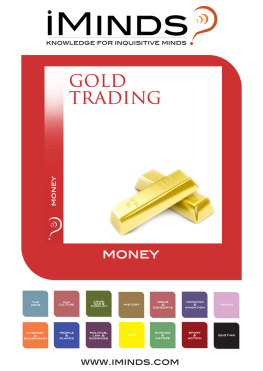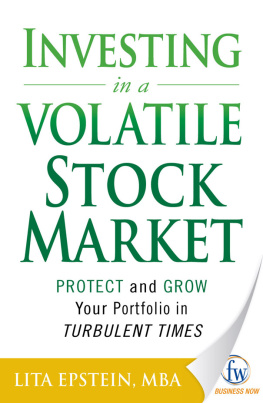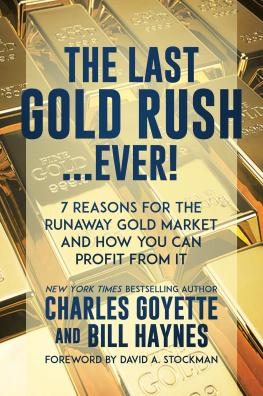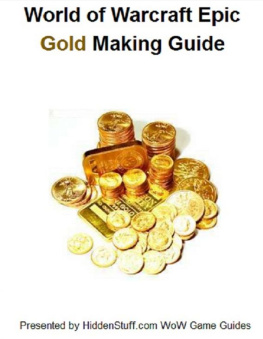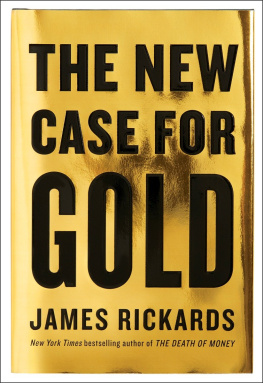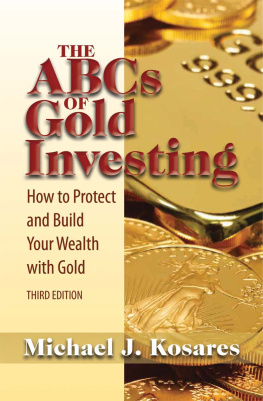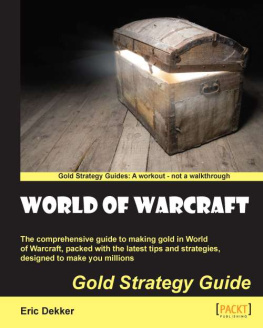How to PROFIT in GOLD
How to PROFIT in GOLD
Professional Tips and Strategies for Todays Ultimate Safe Haven Investment
JONATHAN SPALL


Copyright 2011 by Jonathan Spall. All rights reserved. Except as permitted under the United States Copyright Act of 1976, no part of this publication may be reproduced or distributed in any form or by any means, or stored in a database or retrieval system, without the prior written permission of the publisher.
ISBN: 978-0-07-175911-3
MHID: 0-07-175911-5
The material in this eBook also appears in the print version of this title: ISBN: 978-0-07-175195-7, MHID: 0-07-175195-5.
All trademarks are trademarks of their respective owners. Rather than put a trademark symbol after every occurrence of a trademarked name, we use names in an editorial fashion only, and to the benefit of the trademark owner, with no intention of infringement of the trademark. Where such designations appear in this book, they have been printed with initial caps.
McGraw-Hill eBooks are available at special quantity discounts to use as premiums and sales promotions, or for use in corporate training programs. To contact a representative please e-mail us at bulksales@mcgraw-hill.com.
This publication is designed to provide accurate and authoritative information in regard to the subject matter covered. It is sold with the understanding that neither the author nor the publisher is engaged in rendering legal, accounting, securities trading, or other professional services. If legal advice or other expert assistance is required, the services of a competent professional person should be sought.
From a Declaration of Principles Jointly Adopted by a Committee of the American Bar Association and a Committee of Publishers and Associations
TERMS OF USE
This is a copyrighted work and The McGraw-Hill Companies, Inc. (McGraw-Hill) and its licensors reserve all rights in and to the work. Use of this work is subject to these terms. Except as permitted under the Copyright Act of 1976 and the right to store and retrieve one copy of the work, you may not decompile, disassemble, reverse engineer, reproduce, modify, create derivative works based upon, transmit, distribute, disseminate, sell, publish or sublicense the work or any part of it without McGraw-Hills prior consent. You may use the work for your own noncommercial and personal use; any other use of the work is strictly prohibited. Your right to use the work may be terminated if you fail to comply with these terms.
THE WORK IS PROVIDED AS IS. McGRAW-HILL AND ITS LICENSORS MAKE NO GUARANTEES OR WARRANTIES AS TO THE ACCURACY, ADEQUACY OR COMPLETENESS OF OR RESULTS TO BE OBTAINED FROM USING THE WORK, INCLUDING ANY INFORMATION THAT CAN BE ACCESSED THROUGH THE WORK VIA HYPERLINK OR OTHERWISE, AND EXPRESSLY DISCLAIM ANY WARRANTY, EXPRESS OR IMPLIED, INCLUDING BUT NOT LIMITED TO IMPLIED WARRANTIES OF MERCHANTABILITY OR FITNESS FOR A PARTICULAR PURPOSE. McGraw-Hill and its licensors do not warrant or guarantee that the functions contained in the work will meet your requirements or that its operation will be uninterrupted or error free. Neither McGraw-Hill nor its licensors shall be liable to you or anyone else for any inaccuracy, error or omission, regardless of cause, in the work or for any damages resulting therefrom. McGraw-Hill has no responsibility for the content of any information accessed through the work. Under no circumstances shall McGraw-Hill and/or its licensors be liable for any indirect, incidental, special, punitive, consequential or similar damages that result from the use of or inability to use the work, even if any of them has been advised of the possibility of such damages. This limitation of liability shall apply to any claim or cause whatsoever whether such claim or cause arises in contract, tort or otherwise.
In Memoriam
Jack Spall
19302009
Preface
I believe that too many books on the gold market concentrate on theory and some notion of how it ought to operate. I am not an academic, and I have no research backgroundin fact, I recently sat eating dim sum with a friend from the market, and we were giggling at the notion that there are people who believe that supply and demand are always the prime determinants of moves in the gold price just as if it was a normal commodity. All highly childish, and while they are the drivers from time to time, they are most certainly not always, and when they are, it is generally a very short-lived phenomenon. My knowledge of this field is firsthand, and to write this book on what interests traders, how the market works, and what dealers concentrate on, I have drawn upon the experience I gained working in a trading room for a living.
I started my full-time career in the gold market in 1983. Apart from the odd foray as a foreign exchange and bond trader, this is what I have spent my working life doingtrading and talking to customers about precious metals markets. Over the last 27 years or so, I have been employed by four of the worlds largest banks and always for those that have had a strong position in this market.
During my career I have lived and worked in New York, London, Hong Kong, and Sydney. I have been an interbank market maker on three continents, and I have traveled to 70 or so nations to meet with central banks and finance ministries to discuss the outlook for gold. I have sat with mining companies to debate hedging strategies and traveled over a mile underground to see the ore being extracted. Currently the majority of my time is spent talking to those involved with hedge, pension, and sovereign wealth funds on the events surrounding the recent extraordinary rise in the metals price.
While I believe there is a strong argument that gold has been money for thousands of years and that the events of the last 20 years or so, including our obsession with paper money and ever-increasing levels of complexity, could well have been an aberration, I have resisted the temptation to delve into Egyptians, Aztecs, and Incas. Many authors are far more interested in this than I, and they will have covered this field so much better.
Therefore, this book contains very little about the history of gold. Instead, it is much more about how professional traders operate and the types of factors that influence their decision making. It also covers the various exchanges that they use and generally how the gold market works.
In this updated version of my book I have dispensed with the chapters on mining and refining and instead have concentrated much more on the events behind the rally in gold and what could once more propel the market to fresh all-time highs.
Acknowledgments
How to Profit in Gold builds and expands on a number of themes that were originally explored in Investing in Gold, which was published by McGraw-Hill in December 2008. This book keeps many of these threads and in particular how bank traders view the gold market and how they operateso many of the acknowledgments remain exactly the same. However, I would like to single out Suki Cooper of the Commodities Research team at Barclays Capital for particular thanks in putting together the various charts that underscore my arguments as well as Philip Klapwijk of GFMS, Matt Graydon of the World Gold Council, and Matthew Turner of Virtual Metals for allowing me to reproduce their updated data.
Next page


